The U.S. National Park Service has launched a successful campaign this year called #FindYourPark to celebrate the 100th birthday of the park service. The idea is to find a national park to visit and appreciate. I think the better slogan would be #FindTheOutside. Find that place where you can sit and observe. Find that place where you can listen and smell. Find that place in nature where you can learn. For 12 students from Mitchell Community College, that place just happened to be our nation’s first national park, Yellowstone. However, it wasn’t so much the typical attractions that made this trip special. It was the remote areas that gave us the opportunity to get away and experience wildness.
16 June
From Charlotte to Bozeman–> through Paradise Valley–> Gardiner–> Mammoth
We arrived in Bozeman a little after lunch and slowly started our journey towards the north entrance. As we rode through the remnants of the Pinedale glacial period (70,000 – 13,000 years ago), we searched for osprey and eagles in the cottonwoods that line the banks of the Yellowstone River. The Yellowstone River is the longest, undammed river in the U.S. and one of the few that flows northward.
It is strange that Lewis and Clark made it to about where Livingston, Montana is today, but did not explore the source of the river. If they would have chosen to travel a little further south, they would have certainly seen the many geological wonders. Clark wrote the following in 1809:
“At the head of this river the natives give an account that there is frequently heard a loud noise, like thunder, which makes the earth tremble. They state that they seldom go there because their children cannot sleep.”
After arriving in Gardiner and checking into our lodge, we went off to explore some of these geological features at Mammoth, the main headquarters of the park. Bob gave us a wonderful talk on the terraces as we walked the upper boardwalk. These terraces are made of travertine, which is a type of freshwater limestone. The terrace rock consists of calcium carbonate. The addition of carbon dioxide lowers the pH of the water and makes it more acidic. Bob mentioned that the vents frequently change locations. Old, “extinct” springs were evident in every direction. The cool thing about these springs is that they are home to species of bacteria, flies, wasps, spiders, beetles, birds, and other animals. We even came across a white-tailed jackrabbit enjoying a snack. These rabbits have found a good niche in the Mammoth area. Much of the rest of the park receives too much snow, but since Mammoth gets the least precipitation per year in the park, there is enough vegetation to support this species.
17 June
Mammoth–>Norris–>Grand Prismatic–>Old Faithful–>Yellowstone Lake –>Hayden Valley–> Lamar Valley
“The park is just a howling wilderness of three thousand square miles, full of all imaginable freaks of a fiery nature.”
-Rudyard Kipling
As we drove from Gardiner through Mammoth towards Norris, we were entertained by swans, cranes, and yellow-headed blackbirds. We stopped and walked around Norris Geyser Basin, which is the hottest basin in the park with pools around 190°F and a pH of 5.
Sitting above the basin gave us the perfect opportunity to make a connection to what Mitchell CC students are currently doing in our science labs. In 1969, Thomas Brock and his graduate student isolated a bacteria from Mushroom Spring (not far from Norris) that was thriving at 160°F. The bacteria that they isolated was Thermus aquaticus. An enzyme from the bacteria, known as Taq polymerase, allows researchers and students to perform DNA analyses. Mitchell CC students are using a technique called DNA Barcoding to determine insect biodiversity on campus. This bacterium has served as the basis for a $300 million industry per year.
We then drove to Grand Prismatic and then on to Old Faithful for a lunch break. After the big geyser erupted and the huge crowd began to file out, the ravens took advantage of the opportunity by swooping in and eating whatever food had been dropped. These intelligent birds know an opportunity when they see one.
Yellowstone Lake was our next stop. Mr. Parks Davidson taught us about the ecosystem of this lake, which is actually the largest high elevation lake in North America. Lynn led an exciting discussion about the lodgepole pine trees that surrounded us. She even tried to get one of the cones to burst open in her hand, but it wasn’t quite hot enough.
As we got out of the car at Mud Volcano, our next stop, we immediately smelled rotten eggs. Members of the Washburn expedition named “Mud Volcano” in 1870 for the cone-shaped mud that covered it. However, by 1872, an explosion had blown away the mud. The smell comes from hydrosulfide gas, which is converted to sulfuric acid by microbes. Sulfuric acid breaks down the rock, and the bubbling is the release of the gases. The thermal features here are mostly mud pots and fumaroles simply because the area does not have enough ground water to make geysers or hot springs.
Elizabeth led the discussion at our next stop, the beautiful Hayden Valley. This valley was named for Ferdinand Hayden, a geologist and surveyor, who led a geological expedition in 1871. His findings played an integral part into Yellowstone becoming a national park in 1872. Elizabeth taught us about the formation of the valley and how it differs from the Lamar Valley. As we sat and listened, we watched a bald eagle land along the river.
After supper at Roosevelt, we traveled through the Lamar Valley to Cooke City. On our way, we stopped at Slough Creek and watched some of the Junction Butte wolf pack at their den site. The pups were in and out of view, as were several of the yearlings. We even turned our scopes around and were able to see a grizzly sow with two cubs across the road. To cap off an exciting day, we heard the pack howl several times.
18 June
Slough Creek–> Mt. Washburn–> Grand Canyon of the Yellowstone–> Cooke City
Our first alpine hike of the trip was scheduled this morning, a steady climb up Mt. Washburn. What scheduled was having a cinnamon-colored black bear cross the road right in front of us on our way to the valley. We pulled into Slough Creek and watched the den site for about 30 minutes. The pups were again in and out of view. After eating breakfast at Roosevelt, we headed for Washburn.
In 1870, General Henry Dana Washburn led a military expedition into this territory along with Nathanial Langford, Cheyney Doane and others. At the end of August 1870, while scouting a direct route to the Grand Canyon of the Yellowstone, the group reached the summit of mountain. They named it after their leader. Doane’s description of the summit is as follows:
“The view from the summit is beyond all description…A single glance at the interior slopes of the ranges shows that a former complete connection existed, and that the great basin has been formerly one vast crater of a now extinct volcano.”
Half of our group started at the Chittenden road lot with the other half starting from Dunraven Pass. This trail from the south is actually an old cut road that visitors could once drive up. It’s short, but sneaky. You must gain around 1400 feet in elevation in just over 3 miles. Golden-mantled chipmunks scurried along the rocks, yellow-bellied marmots ducked in and out of crevices, Clark’s nutcrackers controlled the skies, and Douglas firs and white-bark pines held their ground, even at the high elevations. This really excited Laura, since she was our white-bark pine expert. The wind was really strong towards the top, so it was nice to catch a break inside the fire tower to rest and eat lunch.
Before heading back through the Lamar valley for the evening, we made a stop at Artist Point to take in a beautiful view of the Lower Falls. It’s not surprising that on that same 1870 expedition, Nathaniel Langford said, “A grander scene than the lower cataract of the Yellowstone was never witnessed by mortal eyes.” Even with the heavy crowds of people, this is a must stop.
19 June
Lamar Valley–> Tower Junction–> Pebble Creek–> Cooke City–> Trout Lake
“There is something in the wild romantic scenery of this valley which I cannot nor will I attempt to describe; but the impressions made upon my mind while gazing from a high eminence on the surrounding landscape one evening as the sun was gently gliding behind the western mountain and casting its gigantic shadows across the vale were such as time can never efface from my memory.”
—Osborne Russell describing the Lamar Valley in 1835
Our day started at 0430 this morning so that we could meet Dr. Nathan Varley in the valley by 0500. We started off observing a bald eagle just beside the river and a couple of coyotes and sandhill cranes on further down. Several pronghorn and 4 bull elk were grazing just up the slopes from our next pullout. We soon arrived at an osprey nest, and the male and female were both there. We watched the male leave and bring several sticks back to repair some spots in the nest. As we arrived at Slough creek, it soon became apparent that others had the same idea. We found a spot on a hill that would give us a great view of the den. For the next hour, we watched both the wolves as well as two grizzlies wandering around the opposite slopes. There were also bighorn rams just above the wolf den. It seems bold that they are that close.
After leaving Slough Creek, we drove to Tower Falls where we watched a bighorn ewe with a lamb on the opposite side of the canyon. There was also a peregrine falcon circling overhead. Our last stop of the day with Nathan was at the Pebble Creek Campground where we watched a family of mountain goats walk up the cliffs with ease.
After a midday break, we hiked around Trout Lake and enjoyed the beauty of the area. It was here that Kathy taught us about the caldera that we viewed yesterday, and Michael led a discussion on cutthroat trout. After the hike, Diana discussed raven biology. She even had a raven-fact foldable for everyone! On the way back to Cooke City, we stopped at Warm Creek (misleading) for a foot-soak challenge.
20 June
Yellowstone–> Beartooths–> Hartman Gallery
We were all excited about meeting Dan Hartman this morning for a hike up to an owl nest. Dan is a wildlife photographer and naturalist, but also a good friend who has always been generous with his time. When we got to the nest, we had a hard time finding the female great gray until a raven flew close. She appeared for a while then disappeared in the woods. We waited for a couple of hours, but never did see the chicks.
Dan offered to take us to a different nest so we agreed to follow him (without hesitation). We were about 500 ft. past the tree line when we heard the calling, or begging, from the owl chicks. When we came upon them, the chicks were all 3 sitting on the same branch. The mother had just flown away after feeding them. We stood still and watched the chicks for the next 30 minutes, and even were able to find the mother sitting close by. What an exciting time to be able to see this bird that most people who visit Yellowstone never get to see!
After leaving the area, we checked out an aspen grove with Dan that was filled with red-naped sapsuckers, hairy woodpeckers, bluebirds, and flickers. We then headed into the Beartooths to have our minds blown from the scenery. After making several stops, we ate lunch at the “Top of the World”. It was here where we discussed trophic cascades and also where Holly taught us about grizzly bears.
On the way back, we found a great-horned owl nest that was occupied. We also stopped at an aspen grove so that Jim could talk to us about aspen trees and their importance in the ecosystem.
When we got back, we stopped in at the Hartman house and gallery for a visit. After supper, some of us spent one last night in the valley observing.
21 June
Cooke City–>Yellowstone Picnic Area–> Mammoth–> Gardiner
After breakfast at the Bear Claw Café, we packed up and headed through the Lamar for the last time. Our plan for the day was to hike the Yellowstone Picnic Trail. On our way to the parking lot and trailhead we came across a black bear. He already had quite the audience so we didn’t stay long.
The first part of the trail was filled with excitement and anticipation because we all knew that we would soon learn all about bison and pronghorn behavior from Will and Bedford, respectfully. Bedford even had a pronghorn show up for his talk. The hike was great with many wonderful views of the Yellowstone River. We were even entertained by several marmots trying to seek shelter from the strong winds.
We spent the rest of the evening at Mammoth before supper in Gardiner.
22 June
Gardiner–> Bozeman to Charlotte–> Back home
Another year of the program is complete. This year included lots of wonderful hikes, beautiful scenery, and rare wildlife sightings. We saw lots of old friends and made new ones. Hopefully, using places like Yellowstone as a classroom improves our understanding of biology as well as helps us to better appreciate nature. Go forth and find your “park”, whether that’s a national park, state park, refuge area, the woods behind your house, or a tree in your backyard. Take time to be still and observe.

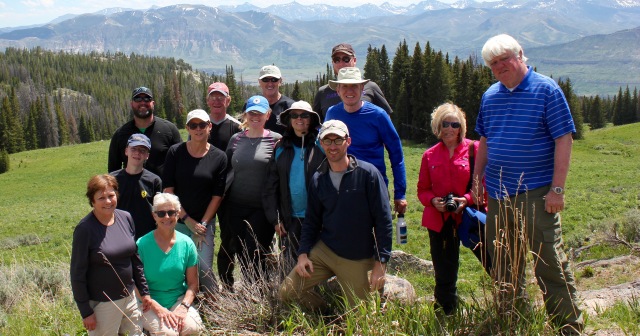







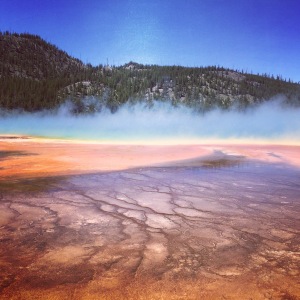
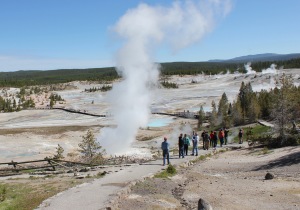





















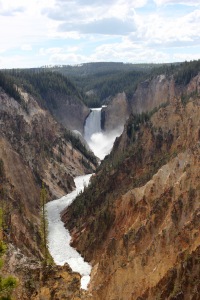








































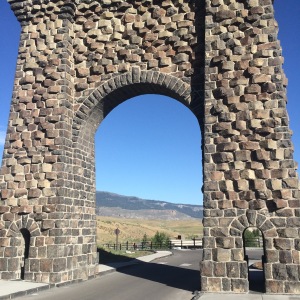
Enjoyed narrative and pictures.!
Bill Leach
Thanks Bill. You would have loved watching the owls.
Sums the entire trip up perfectly.
Thanks again for going and for teaching us about the caldera. We’re all experts now!